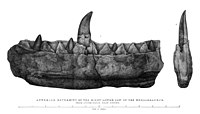Inferior Oolite
| Inferior Oolite Group | |
|---|---|
| Stratigraphic range: Aalenian – Bathonian (Middle Jurassic) | |
 Inferior Oolite at Leckhampton Hill, Gloucestershire. | |
| Type | Group |
| Underlies | Great Oolite Group |
| Overlies | Lias Group |
| Thickness | 0 - 120m |
| Lithology | |
| Primary | limestones |
| Other | sandstone, mudstone |
| Location | |
| Country | England |
The Inferior Oolite is a sequence of Jurassic age sedimentary rocks in Europe. It was deposited during the Middle Jurassic.[1] The Inferior Oolite Group as more recently defined is a Jurassic lithostratigraphic group (a sequence of rock strata) in southern and eastern England . It has been variously known in the past as the Under Oolite (or Oolyte), the Inferior Oolite, the Inferior Oolite Series and the Redbourne Group.[2]
Outcrops
The rocks are exposed from Dorset and Somerset eastwards and northwards through the English Midlands to Yorkshire.[3] It is present at depth in the Wessex-Weald Basin, where it reaches its greatest thickness of 120m.
Lithology and stratigraphy

The Group comprises up to 120m thickness of oolitic limestones and subordinate sandstones and mudstones laid down during the Jurassic Period. In the East Midlands it comprises (in descending order i.e. oldest last) the Lincolnshire Limestone, Grantham and Northampton Sand formations whereas in the Cotswold Hills it comprises the Salperton Limestone, Aston Limestone and Birdlip Limestone formations.[4][5] The limestones are rich in organic material.[citation needed] The ammonite Parkinsonia parkinsoni, an index fossil for the Bathonian,[6] is native to the Inferior Oolite of Burton Bradstock.[citation needed]
Vertebrate fauna
Ornithopod tracks geographically located in North Yorkshire, England.[1] Ornithopod and theropod tracks present in North Yorkshire, England.[7]
Color key
|
Notes Uncertain or tentative taxa are in small text; |
| Dinosaurs of the Inferior Oolite | ||||||
|---|---|---|---|---|---|---|
| Genus | Species | Location | Stratigraphic position | Material | Notes | Images |
|
C. epioolithicus |
|
   | ||||
|
Indeterminate |
|
|||||
|
D. hesperis |
|
"Skull elements."[10] |
||||
|
M. nethercombensis[9] |
|
"Dentaries, vertebrae, pubis, femora, [and] tibiae."[10] | ||||
|
M. bucklandii |
||||||
|
M. hesperis[1] |
|
"Skull elements."[10] |
Moved to the new genus Duriavenator in 2008. | |||
|
Indeterminate |
||||||
|
Indeterminate |
|
Previously referred to Stegosaurus. | ||||
See also
Footnotes
- ^ a b c d e Weishampel, David B; et al. (2004). "Dinosaur distribution (Middle Jurassic, Europe)." In: Weishampel, David B.; Dodson, Peter; and Osmólska, Halszka (eds.): The Dinosauria, 2nd, Berkeley: University of California Press. Pp. 538–541. ISBN 0-520-24209-2.
- ^ Waters, C.N. et al. 2007 Stratigraphical Chart of the United Kingdom: Southern Britain British Geological Survey (poster)
- ^ British Geological Survey 1:50,000 scale geological map (England & Wales) sheets
- ^ http://www.bgs.ac.uk/Lexicon/lexicon.cfm?pub=INO (BGS on-line lexicon of rock units)
- ^ Waters, C.N. et al 2007 Stratigraphical Chart of the United Kingdom:Southern Britain British Geological Survey (poster)
- ^ Wynn Jones, R: Applied Paleontology. page 146, Cambridge University Press
- ^ a b "Dinosaur distribution (Middle Jurassic; Europe; North Yorkshire, England)." Weishampel, et al. (2004). Page 539.
- ^ "Dinosaur distribution (Middle Jurassic; Europe; Wiltshire, England)." Weishampel, et al. (2004). Page 540.
- ^ a b c d e "Dinosaur distribution (Middle Jurassic; Europe; Dorset, England)." Weishampel, et al. (2004). Page 539.
- ^ a b c "Table 4.1," in Weishampel, et al. (2004). Page 73.
- ^ "Dinosaur distribution (Middle Jurassic; Europe; Gloucestershire, England)." Weishampel, et al. (2004). Page 538.
- ^ BENSON, R. B. J. (2009), AN ASSESSMENT OF VARIABILITY IN THEROPOD DINOSAUR REMAINS FROM THE BATHONIAN (MIDDLE JURASSIC) OF STONESFIELD AND NEW PARK QUARRY, UK AND TAXONOMIC IMPLICATIONS FOR MEGALOSAURUS BUCKLANDII AND ILIOSUCHUS INCOGNITUS. Palaeontology, 52: 857–877. doi: 10.1111/j.1475-4983.2009.00884.x
- ^ "Dinosaur distribution (Middle Jurassic; Europe; Northamptonshire, England)." Weishampel, et al. (2004). Pages 539-540.
- ^ "Dinosaur distribution (Middle Jurassic; Europe; Somerset, England)." Weishampel, et al. (2004). Page 538.
References
- M. J. Benton and P. S. Spencer. 1995. Fossil Reptiles of Great Britain. Chapman & Hall, London 1-386
- J. B. Delair. 1973. The dinosaurs of Wiltshire. The Wiltshire Archaeological and Natural History Magazine 68:1-7
- Weishampel, David B.; Dodson, Peter; and Osmólska, Halszka (eds.): The Dinosauria, 2nd, Berkeley: University of California Press. 861 pp. ISBN 0-520-24209-2.
